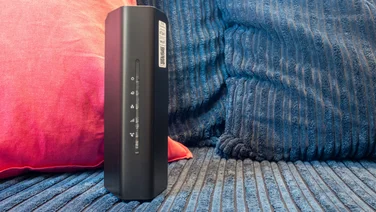To help us provide you with free impartial advice, we may earn a commission if you buy through links on our site. Learn more







- Excellent price
- Decent software features
- OneMesh extender support
- Slow Wi-Fi
- No support for 5G internet
No internet connection is 100% reliable but an outage can ruin your working day. The TP-Link Archer MR600 provides a backup plan. Slot in a data SIM from any provider and it will automatically switch over to mobile internet whenever your main connection goes down.
The MR600 isn’t the only router we’ve seen with support for mobile internet, but it’s certainly the cheapest. There are two big reasons for that: it doesn’t support fast 5G mobile networks, and its wireless capabilities are decidedly on the lightweight side. That means it works best for short-range, low-demand connections – although if you need faster Wi-Fi you can always partner it with a separate wireless access point or mesh.
TP-Link Archer MR600 V2 review: What you need to know
The Archer MR600 works like any other wireless router. It connects to an internet modem via Ethernet and broadcasts dual-band Wi-Fi on the 2.4GHz and 5GHz radio bands. Unlike most current routers, however, it uses the old Wi-Fi 5 standard rather than the faster Wi-Fi 6; TP-Link claims maximum connection speeds of 300Mbits/sec on the 2.4GHz band and 867Mbits/sec in the 5GHz range. There are also four Gigabit Ethernet ports for wired connections.







What makes the MR600 different to most routers is the micro-SIM slot at the rear. Insert a data-enabled SIM from any major provider and the router will automatically enable mobile internet as an alternative to the usual fixed-line connection. While 5G services aren’t supported, the Archer MR600 can connect to any 4G network at a theoretical data rate of up to 300Mbits/sec.
READ NEXT: The best mesh routers you can buy
TP-Link Archer MR600 V2 review: Price and competition
The Archer MR600 is very affordable: at £119 it’s actually cheaper than most non-4G routers we’ve tested. Then again, it’s also slower than most of them.
If you’re looking for a SIM-enabled router with high-end wireless, the only alternative we’ve seen is the Netgear Orbi NBK752. This powerful mesh system uses Wi-Fi 6, and also supports ultrafast 5G mobile networks. It’s far, far more expensive than the Archer, however, costing a stiff £1,100.
Another option is to invest in a portable Wi-Fi 6 hotspot like the Netgear Nighthawk M5. This pocket-sized router can run off either batteries or mains power and, again, connects to the internet over either a regular Ethernet link or an integrated 5G SIM slot. It’s simpler and cheaper than the NBK752 but at £780 it’s still in a different ballpark to the Archer MR600.
TP-Link offers its own low-cost 4G hotspot, the M7650, but this is again limited to Wi-Fi 5 and only supports mobile internet, with no fixed-line option. For the odd situation where you need internet on the go, it might make more sense to simply use your phone in tethering mode.
TP-Link Archer MR600 V2 review: Design and features
The MR600 is a small, sleek, shiny unit with two short antennas sticking up at the back. The high-gloss finish gives a great first impression, while also making dust and fingerprints highly visible. At the front, a few illuminated indicators shine through the plastic casing showing the status of your internet connection and internal networks, although they’re so dim you really have to stand directly over the router to see them.
At the rear sit the four Gigabit Ethernet ports (if you’re only using 4G internet then you can use all of these for wired clients) and a SIM slot; this uses the 15mm micro-SIM format, but an adapter for nano-SIMs is thoughtfully included in the box so you can use whichever type you have to hand.
There are also buttons for turning the power and Wi-Fi radios on and off and for enabling WPS pairing. You won’t find any fancy features like USB or 2.5GbE connectors but, at this price, that’s hardly surprising. On the underside, two anchoring slots make it easy to wall-mount the router, should you wish to.







Management is via either a web portal or the TP-Link Tether app. The MR600 uses TP-Link’s standard firmware, so you get a familiar interface with many of the same features as TP-Link’s high-end routers. These include configurable QoS settings, allowing you to prioritise both particular clients and specific protocols, and an incoming VPN service with dynamic DNS, allowing convenient and secure access to your home network over the internet.







There’s a simple firewall, too, and the option to block specific sites and set schedules for individual devices. However, this router doesn’t support TP-Link’s HomeShield service, which offers more extensive security and parental control features.
TP-Link Archer MR600 review: Performance
As I’ve noted, the Archer MR600 is far from a wireless powerhouse. The router uses Wi-Fi 5 instead of the faster Wi-Fi 6 technology and, with an advertised top speed of 867Mbits/sec, this isn’t even a particularly fast implementation. The two small aerials don’t bode well for coverage, either.


To see how the router performs in practice, I installed the MR600 in my study and connected one of the Ethernet ports to an Asustor Drivestor 4 Pro NAS appliance. I then took a test laptop to various rooms in my home, copied a set of large data files to and from the NAS, and recorded the read and write speeds I obtained in different locations. Here’s what I saw, along with results from a selection of other routers for comparison:The MR600 delivered a usable wireless signal all around the house but its performance couldn’t match up to even today’s cheapest routers. For context, the D-Link R15 Eagle Pro AI costs a mere £56, while TP-Link’s own Archer AX53 sells for £126.
And while the two Netgear products in the chart are far more expensive than the MR600, they show what Wi-Fi 6 is capable of. The top-of-the-line Netgear Nighthawk RAXE500, with a list price of £550, includes support for the latest Wi-Fi 6E standard but the speeds shown above were achieved using a regular Wi-Fi 6 connection. The Netgear Orbi NBK752 mesh system is pricier still, but it’s clearly in a different league to the TP-Link when it comes to wireless speed and range.
There are ways to get better performance out of the Archer. TP-Link’s OneMesh platform lets you pair it with other TP-Link routers to create an ad hoc mesh. This won’t increase headline speeds but it could reduce the drop-off in other rooms. Alternatively, you can disable the MR600’s internal Wi-Fi radios and connect it to a dedicated access point or a separate mesh system, allowing you to get Wi-Fi 6 while keeping the Archer’s 4G capabilities.
On that note, 4G performance is acceptable rather than great: the Google Speed Test tool measured a download speed of 25Mbits/sec and an upload rate of 14Mbits/sec over the Vodafone network. That’s enough bandwidth for a few people to share data, use online applications and even participate in conference calls, but it lags conspicuously behind Netgear’s Orbi NBK752 and Nighthawk M5 routers, which both managed around 35Mbits/sec over 4G.
The Archer is, however, very prompt at managing connections: when I “accidentally” disconnected the fixed broadband line, the MR600 automatically switched over to my Vodafone 4G SIM in ten seconds flat. It’s also less power-hungry than the Orbi, drawing around 7W while idle and peaking at 11W.
READ NEXT: Our full roundup of the best wireless routers available
TP-Link Archer MR600 review: Verdict
By today’s standards, the Archer MR600 offers sub-par wireless performance. The 4G connection isn’t particularly fast either, while 5G speeds are forever out of reach.
Even so, it’s a proposition that could make a lot of sense for home workers or small offices. We wouldn’t want to rely on the 4G connection every day, but it’s fine as a fallback against the occasional broadband outage. And, since the router’s so cheap, you could easily afford to partner it with a second router or a mesh to boost Wi-Fi coverage and performance.
By contrast, more powerful alternatives with 5G and Wi-Fi 6 are far more expensive. So if you’re looking to add a basic degree of fault-tolerance to your internet connection, this unassuming router could well be the smart buy.








